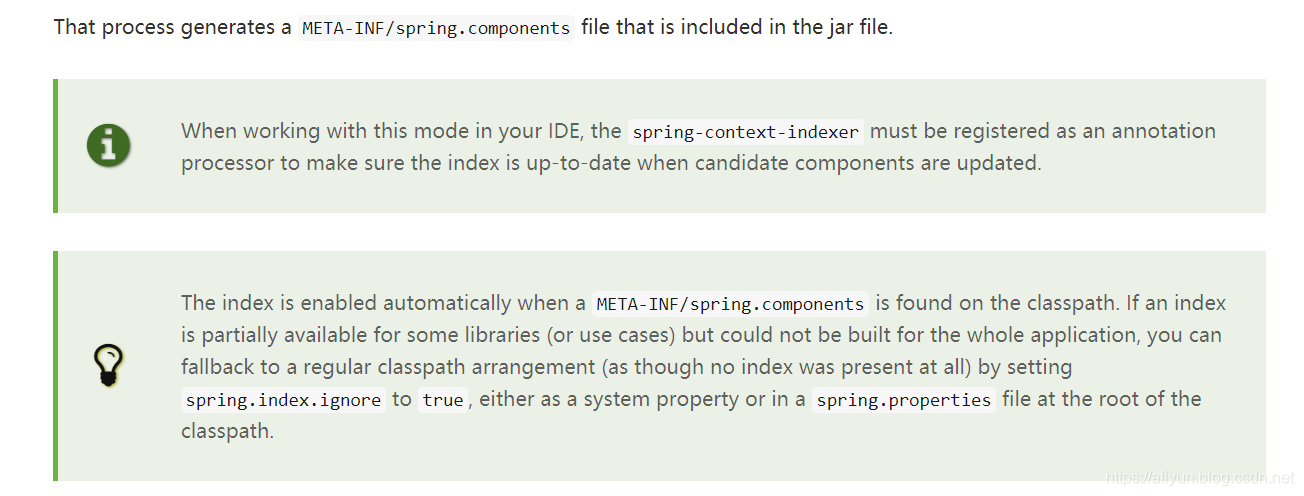@Indexed 注解
本文转载自:https://www.cnblogs.com/aflyun/p/11992101.html
最近在看 SpringBoot 核编程思想(核心篇),看到走向注解驱动编程这章,里面有讲解到:在SpringFramework 5.0 引入了一个注解@Indexed ,它可以为 Spring 的模式注解添加索引,以提升应用启动性能。
在往下阅读的时候,请注意一些模式注解:
| Spring注解 | 场景说明 |
|---|---|
| @Repository | 数据仓库模式注解 |
| @Component | 通用组件模式注解 |
| @Service | 服务模式注解 |
| @Controller | Web控制器模式注解 |
| @Configuration | 配置类模式注解 |
使用场景
在应用中使用@ComponentScan扫描 package 时,如果 package 中包含很多的类,那么 Spring 启动的时候就会变慢。
提升性能的一个方案就是提供一个 Component 的候选列表,Spring 启动时直接扫描注入这些列表就行了,而不需要一个个类去扫描,再筛选出候选 Component。
需要注意的是:在这种模式下,所有组件扫描的目标模块都必须使用这种机制——大白话将就所有的 Component 组件都必须生成到列表文件中去。
While classpath scanning is very fast, it is possible to improve the startup performance of large applications by creating a static list of candidates at compilation time. In this mode, all modules that are target of component scan must use this mechanism.
使用方式
在项目中使用的时候需要导入一个spring-context-indexer jar包。
<dependencies>
<dependency>
<groupId>org.springframework</groupId>
<artifactId>spring-context-indexer</artifactId>
<version>xxxx</version>
<optional>true</optional>
</dependency>
</dependencies>
然后在代码中,对于使用了模式注解的类上加上@Indexed注解即可。如下:
@Indexed
@Controller
public class HelloController {
}
加了上面的依赖后,项目就会自动使用索引的方式启动Spring。
原理说明
摘自官网:

简单说明一下:在项目中使用了@Indexed之后,编译打包的时候会在项目中自动生成META-INT/spring.components文件。
当Spring应用上下文执行ComponentScan扫描时,META-INT/spring.components将会被CandidateComponentsIndexLoader 读取并加载,转换为CandidateComponentsIndex对象,这样的话@ComponentScan不在扫描指定的package,而是读取CandidateComponentsIndex对象,从而达到提升性能的目的。
知道上面的原理,可以看一下org.springframework.context.index.CandidateComponentsIndexLoader的源码。
ublic final class CandidateComponentsIndexLoader {
public static final String COMPONENTS_RESOURCE_LOCATION = "META-INF/spring.components";
public static final String IGNORE_INDEX = "spring.index.ignore";
private static final boolean shouldIgnoreIndex = SpringProperties.getFlag(IGNORE_INDEX);
private static final Log logger = LogFactory.getLog(CandidateComponentsIndexLoader.class);
private static final ConcurrentMap<ClassLoader, CandidateComponentsIndex> cache =
new ConcurrentReferenceHashMap<>();
private CandidateComponentsIndexLoader() {
}
@Nullable
public static CandidateComponentsIndex loadIndex(@Nullable ClassLoader classLoader) {
ClassLoader classLoaderToUse = classLoader;
if (classLoaderToUse == null) {
classLoaderToUse = CandidateComponentsIndexLoader.class.getClassLoader();
}
return cache.computeIfAbsent(classLoaderToUse, CandidateComponentsIndexLoader::doLoadIndex);
}
@Nullable
private static CandidateComponentsIndex doLoadIndex(ClassLoader classLoader) {
if (shouldIgnoreIndex) {
return null;
}
try {
Enumeration<URL> urls = classLoader.getResources(COMPONENTS_RESOURCE_LOCATION);
if (!urls.hasMoreElements()) {
return null;
}
List<Properties> result = new ArrayList<>();
while (urls.hasMoreElements()) {
URL url = urls.nextElement();
Properties properties = PropertiesLoaderUtils.loadProperties(new UrlResource(url));
result.add(properties);
}
if (logger.isDebugEnabled()) {
logger.debug("Loaded " + result.size() + "] index(es)");
}
int totalCount = result.stream().mapToInt(Properties::size).sum();
return (totalCount > 0 ? new CandidateComponentsIndex(result) : null);
}
catch (IOException ex) {
throw new IllegalStateException("Unable to load indexes from location [" +
COMPONENTS_RESOURCE_LOCATION + "]", ex);
}
}
}
使用注意点
虽然这个@Indexed注解能提升性能,但是在使用的时候也需要注意下。
假设Spring应用中存在一个包含META-INT/spring.components资源的a.jar,但是 b.jar 仅存在模式注解,那么使用@ComponentScan扫描这两个JAR中的package时,b.jar 中的模式注解不会被识别,请务必注意这样的问题。
举个列子说明下,能够更好的理解。
DemoA项目(使用
@Indexed注解)

DemoB项目(不使用
@Indexed注解)
SpringBootDemo项目
在此项目中引入DemoA.jar和DemoB.jar。然后进行如下测试,测试代码如下:
配置类,扫描模式注解
@Configuration
@ComponentScan(basePackages = "org.springboot.demo")
public class SpringIndexedConfiguration {
}
测试类:
@Test
public void testIndexedAnnotation(){
AnnotationConfigApplicationContext context = new AnnotationConfigApplicationContext(SpringIndexedConfiguration.class);
System.out.println("获取DemoA Jar中【org.springboot.demo.controller.DemoAController】");
DemoAController demoAController = context.getBean(DemoAController.class);
System.out.println("DemoAController = " + demoAController.getClass());
System.out.println("获取DemoB Jar中【org.springboot.demo.controller.DemoBController】");
DemoBController demoBController = context.getBean(DemoBController.class);
System.out.println("DemoBController = " + demoBController.getClass());
}
结果:
beanDefinitionName = demoAController
获取DemoA Jar中【org.springboot.demo.controller.DemoAController】
DemoAController = class org.springboot.demo.controller.DemoAController
获取DemoB Jar中【org.springboot.demo.controller.DemoBController】
org.springframework.beans.factory.NoSuchBeanDefinitionException: No qualifying bean of type 'org.springboot.demo.controller.DemoBController' available
找不到 DemoBController 。
通过这样一个简单的Demo,验证了上面提到的使用注意点。
对于这种情况,Spring 官网提示了配置相关属性,不再使用index方式启动。要是这样的话,我们完全可以不添加spring-context-indexer 依赖,这样整体就不会使用index模式了。
The index is enabled automatically when a
META-INF/spring.componentsis found on the classpath. If an index is partially available for some libraries (or use cases) but could not be built for the whole application, you can fallback to a regular classpath arrangement (as though no index was present at all) by settingspring.index.ignoretotrue, either as a system property or in aspring.propertiesfile at the root of the classpath.
@Indexed 注解的更多相关文章
- SpringFramework5.0 @Indexed注解 简单解析
目录 使用场景 使用方法 原理说明 使用需注意点 案例说明 参考资料 纸上得来终觉浅 绝知此事要躬行 -陆游 最近在看SpringBoot核编程思想(核心篇),看到走向注解驱动编程这章,里面有讲解到: ...
- mongo注解详解
1.@Entity如果你想通过Morphia把你的对象保存到Mongo中,你首先要做的是使用@Entity注解你的类:@Entity(value="comm_user_favorite_co ...
- 死磕Spring之IoC篇 - BeanDefinition 的解析过程(面向注解)
该系列文章是本人在学习 Spring 的过程中总结下来的,里面涉及到相关源码,可能对读者不太友好,请结合我的源码注释 Spring 源码分析 GitHub 地址 进行阅读 Spring 版本:5.1. ...
- Spring Boot 自动装配(一)
目录 目录 前言 1.起源 2.Spring 模式注解 2.1.装配方式 2.2.派生性 3.Spring @Enable 模块驱动 3.1.Spring框架中@Enable实现方式 3.2.自定义@ ...
- Solr7.x学习(8)-使用spring-data-solr
1.maven配置 <dependency> <groupId>org.springframework.data</groupId> <artifactId& ...
- 学习Spring-Data-Jpa(六)---spring-data-commons中的repository
1.spring-data-commons项目 spring-data-commons项目是所有spring-data项目的核心,我们来看一下该项目下的repository包中的接口和注解. 2.Re ...
- static关键字有何魔法?竟让Spring Boot搞出那么多静态内部类
生命太短暂,不要去做一些根本没有人想要的东西.本文已被 https://www.yourbatman.cn 收录,里面一并有Spring技术栈.MyBatis.JVM.中间件等小而美的专栏供以免费学习 ...
- SpringBoot数据访问(三) SpringBoot整合Redis
前言 除了对关系型数据库的整合支持外,SpringBoot对非关系型数据库也提供了非常好的支持,比如,对Redis的支持. Redis(Remote Dictionary Server,即远程字典服务 ...
- 这样优化Spring Boot,启动速度快到飞起!
微服务用到一时爽,没用好就呵呵啦,特别是对于服务拆分没有把控好业务边界.拆分粒度过大等问题,某些 Spring Boot 启动速度太慢了,可能你也会有这种体验,这里将探索一下关于 Spring Boo ...
随机推荐
- 【VNC】vnc安装oracle的时候不显示图形化界面
背景: 在虚拟机搭建了一个环境,准备安装oracle.但是环境都配置完成后,执行./runInstaller的时候,没有界面显示,只显示下面的界面 多次尝试后,发现,还是这样,期初是因为没有配置DIS ...
- 【RAC】运行root.sh的时候报错root.sh Oracle CRS stack is already configured and will be running under init(1M)
环境:oracle10g 系统:CentOS6.4 开始的时候,在节点1上运行root.sh发现出现90s 的时候hang住了,结束掉,结局完事后,再次运行root.sh报错 WARNING: dir ...
- windows下如何安装Python、pandas
windows下如何安装Python.pandas 本篇主要涵盖以下三部分内容: Python.Pycharm的安装 使用Pycharm创建.运行Python程序 安装pandas 1.Python. ...
- Ubuntu Terminal命令行新建仓库并推送到远程仓库
通常情况下,在本地新建一个仓库之后,需要在远端网页端也新建一个空的同名仓库,然后将两者进行关联才能推送. 那有没有办法直接在命令行就完成从新建到推送的过程而不需要中间在网页端也操作一番呢?办法当然是有 ...
- STM32驱动LCD原理
TFTLCD即薄膜晶体管液晶显示器.它与无源TN-LCD.STN-LCD的简单矩阵不同,它在液晶显示屏的每一个像素上都设置有一个薄膜晶体管(TFT),可有效地克服非选通时的串扰,使显示液晶屏的静态特性 ...
- nokogiri Fail install on Ruby 2.3 for Windows #1456 <From github>
Q: gem install railson nokogiri install fail with error: 'nokogiri requires Ruby version < 2.3, & ...
- 笔记 | 吴恩达新书《Machine Learning Yearning》
这本书共112页,内容不多,偏向于工程向,有很多不错的细节,在此记录一下. 0 书籍获取 关注微信公众号"机器学习炼丹术",回复[MLY]获取pdf 1 测试集与训练集的比例 2 ...
- c#使用谷歌身份验证GoogleAuthenticator
此功能相当于给系统加了个令牌,只有输入对的一组数字才可以验证成功.类似于QQ令牌一样. 一丶创建最核心的一个类GoogleAuthenticator 此类包含了生成密钥,验证,将绑定密钥转为二维码. ...
- 不占用额外内存空间能否做到 将图像旋转90度 N × N矩阵表示的图像,其中每个像素的大小为4字节
给定一幅由N × N矩阵表示的图像,其中每个像素的大小为4字节,编写一种方法,将图像旋转90度. 不占用额外内存空间能否做到? 示例 1: 给定 matrix = [ [1,2,3], [4,5,6] ...
- 线上一次大量 CLOSE_WAIT 复盘
https://mp.weixin.qq.com/s/PfM3hEsDa3CMLbbKqis-og 线上一次大量 CLOSE_WAIT 复盘 原创 ms2008 poslua 2019-07-05 最 ...
